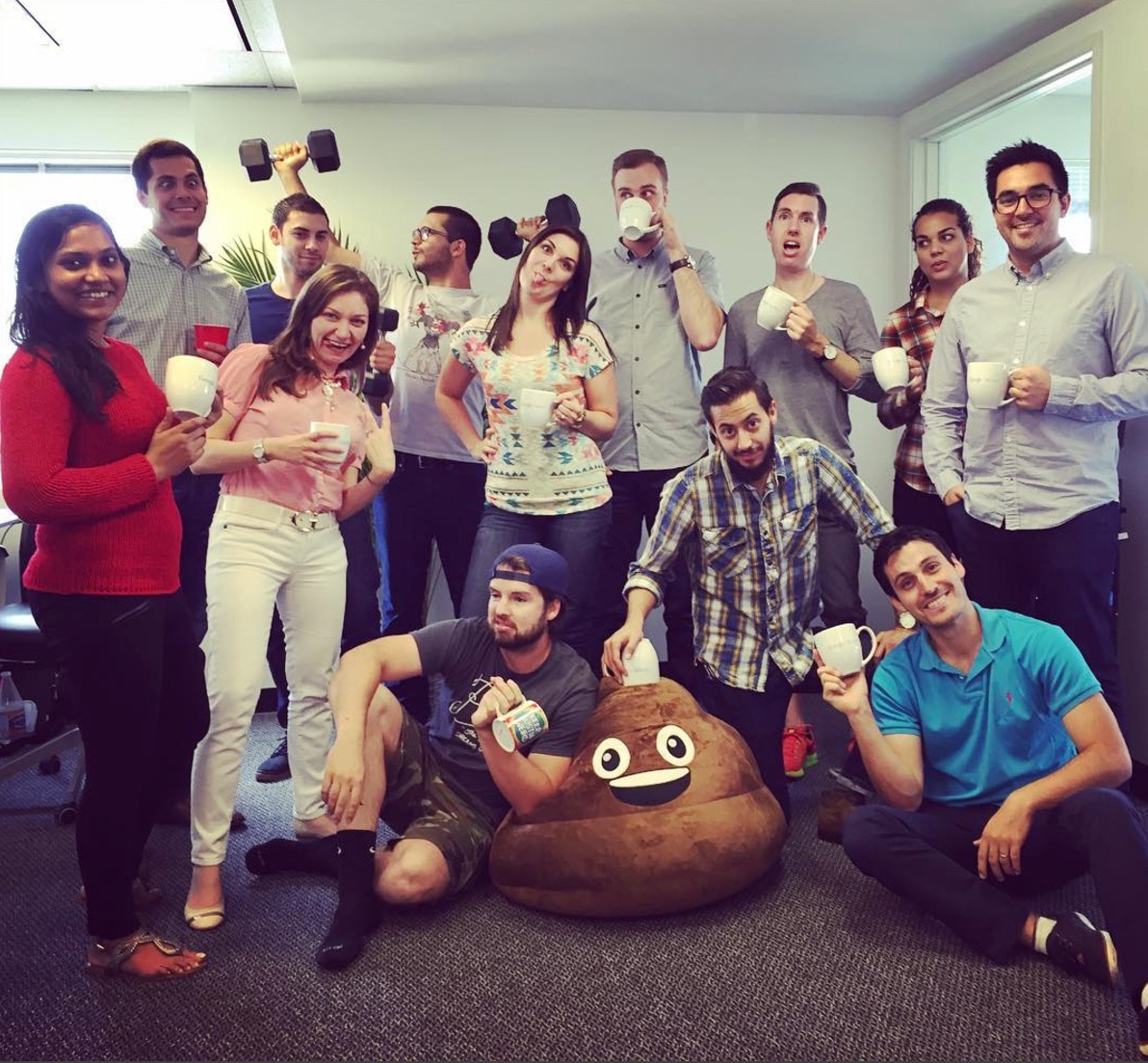In early 2015, Johnathan Dane left his first PPC company in Utah and moved back to his hometown in Southern California. What was the first thing he did when he got back? He started another PPC company and he called it KlientBoost.
He started with no clients, no office, and a one-person team. Armed with some savings from the first company and a designer he convinced to join him, his dream was to build a PPC SaaS company (his first PPC company was an agency).
But he made a key choice early on: instead of starting as a SaaS company, which inevitably would mean little to no revenues early on and thus necessitate raising outside investment, KlientBoost would first start as a PPC agency. This would give them immediate revenue and positive cashflow, and the company would be 100% his.
In 12 months, KlientBoost crossed $100,000 in recurring monthly contracts, a $1.2 million annual run rate. Today the company does $300,000 a month and has 25 employees.
This is the story of how Dane built KlientBoost into a million dollar agency in 12 months by focusing on different strategies in three different phases of his company.
Note: Like this article? We produce stories like these for our clients, learn more here.
Phase 1: Getting Your First Clients
“Do things that don’t scale.” – Paul Graham, Co-Founder, Y-Combinator

In the beginning of 2015, Dane was back in Huntington Beach, ready to start KlientBoost. He had cash in the bank from his first agency and a blog (with barely any traffic) where he wrote his thoughts about PPC strategy. But that was pretty much it.
The first thing he did was unconventional: He hired a designer, full time. This was before he had any clients. He was paying this designer out of his savings.
They had no money for an office or a coworking space. So they met every day at Starbucks. Afraid the Starbucks staff would kick them out for being there all day, every day, they created a “Starbucks schedule”, where they strategically planned a to work at different Starbucks in Orange County every weekday.
The designer was, himself, taking a risk. As Dane puts it, “He left his cozy job to go bum it with me at different Starbucks.”
(They stopped the Starbucks schedule after a while, noting “We figured out that Starbucks doesn’t give a shit.”)

In the first month Dane managed to land their first 3 clients, each paying around $2500 per month. “Within 3 weeks to a month, we were making $7500/month and I was stoked,” Dane says, “Now I could afford to pay [the designer], without losing money from my savings.”
He got these initial clients not through content, but through cold emails. Not by sending thousands of generic emails, but by sending custom emails, and offering specific ideas the recipient could immediately use. He wrote and sent all of the emails manually, to local companies.
Here was his formula:
- Find a company that was spending a lot on ads (using SpyFu)
- Critique their ad-to-landing-page-to-signup flow and give them suggestions on how to improve it
- Present that in a concise email
“I had nothing but time”, he says, describing how he spent so much time writing elaborate cold emails to people who, were more than likely, never going to respond to him. He also loved doing this. “I was so pumped up that I was up until 3AM every day [finding contacts],” he says.
He also added quirks to these emails that showed his personality. At the end of these emails, he’d include an animated gif of a cowboy riding a slice of pizza.
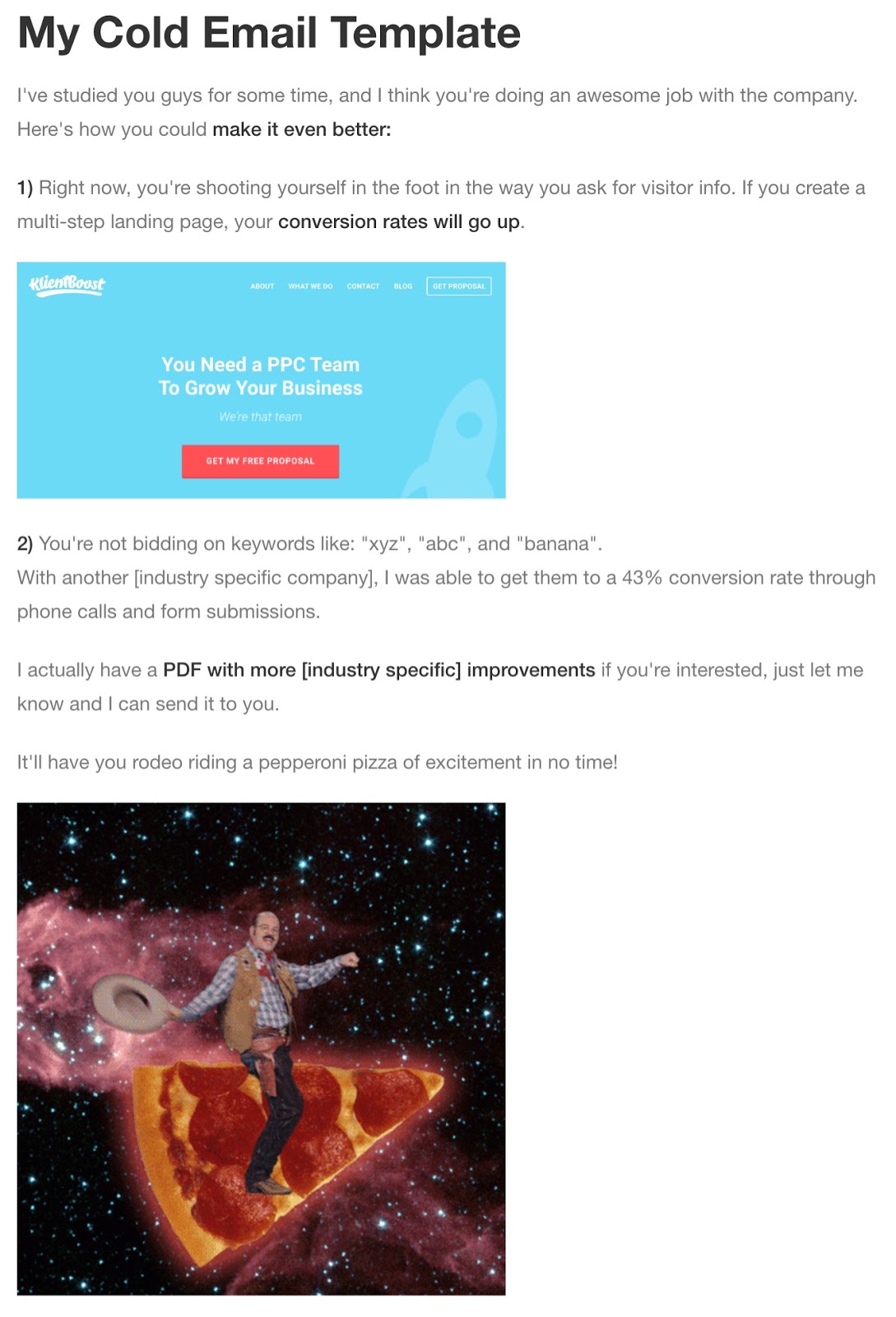
Why?
“I was trying to be funny. I was trying to be different.”
This theme of being personal and “being different” keeps coming up throughout our conversation: in their site design, and in their sales process. Dane carries that vibe himself. I can tell it’s part of his personality.
When we speak for this interview, it’s our first time talking ever but we immediately start cracking jokes and laughing. Here’s us just 5 seconds into the recording:
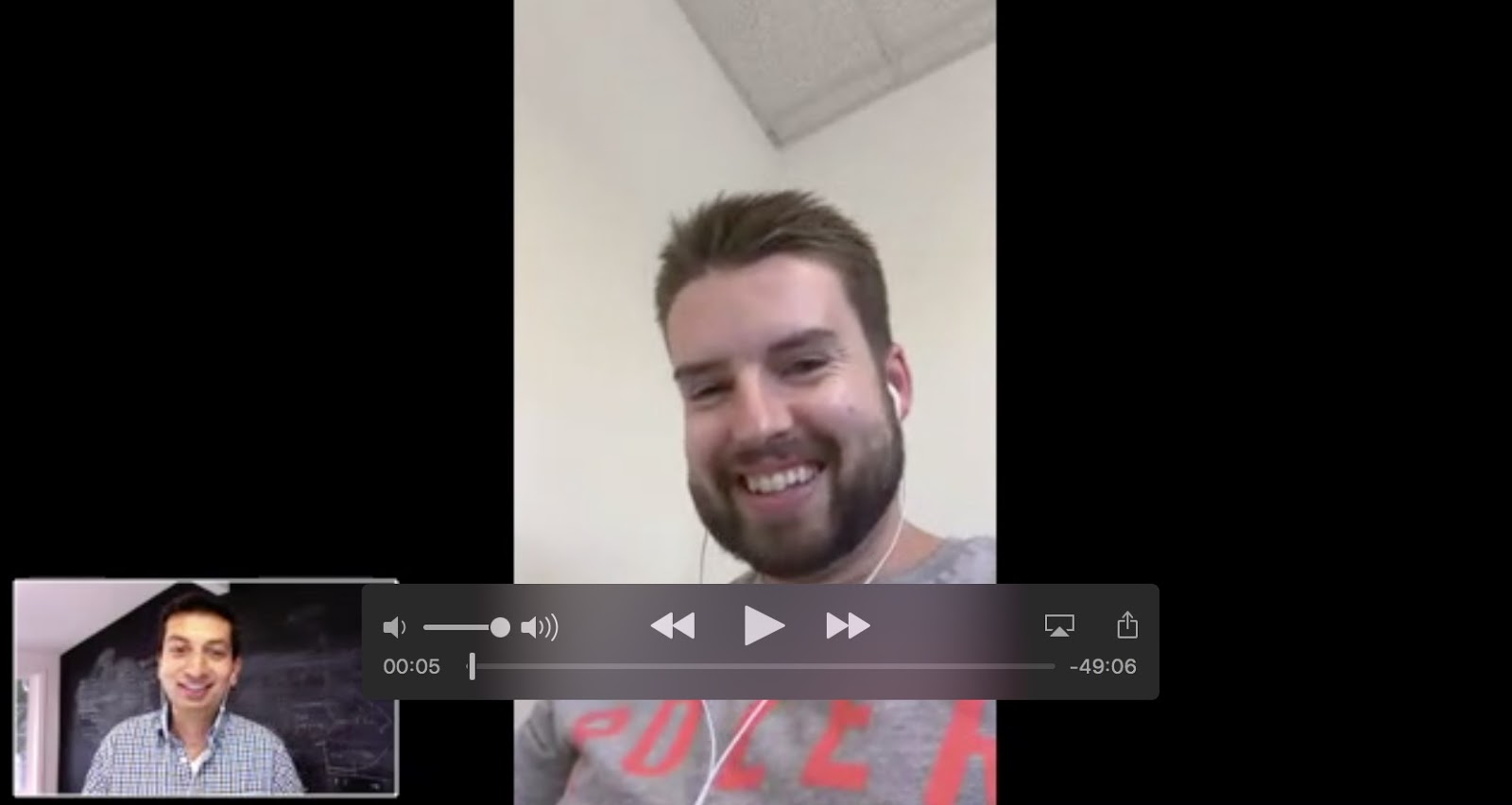
At one point early on in the conversation he says, matter of factly, “I knew that when I grew up, I wanted to make a lot of money.” I start laughing and mention how unapologetic that statement is. But somehow I’m not turned off by it. He has an unassuming, casual vibe about him, like we’ve been friends for years, and we end up laughing about the honesty of it.
He carries this into his work, seeking to build friendships with clients, not a relationship of transactions.
In total, he tells me he sent about 100 of these custom cold sales emails and got 3 deals in the first month. That’s an impressive 3% deal rate from cold emails, which is a testament to the good, custom advice in them.
One month in, with the immediate cash pressure lifted, Dane decided to “level up”.
Phase 2: Growth Through Content and Partnerships
After landing his first few clients, Dane says his mindset shifted to partnering with bigger companies that already had KlientBoost’s ideal clients. “Let’s try to level up and be mentioned with these other companies. Doing these public displays where they’re kind of vouching for us,” he says.
The First Partnership: A KlientBoost Taco Party
The first public display was hosting a party at Unbounce’s CRO Day.
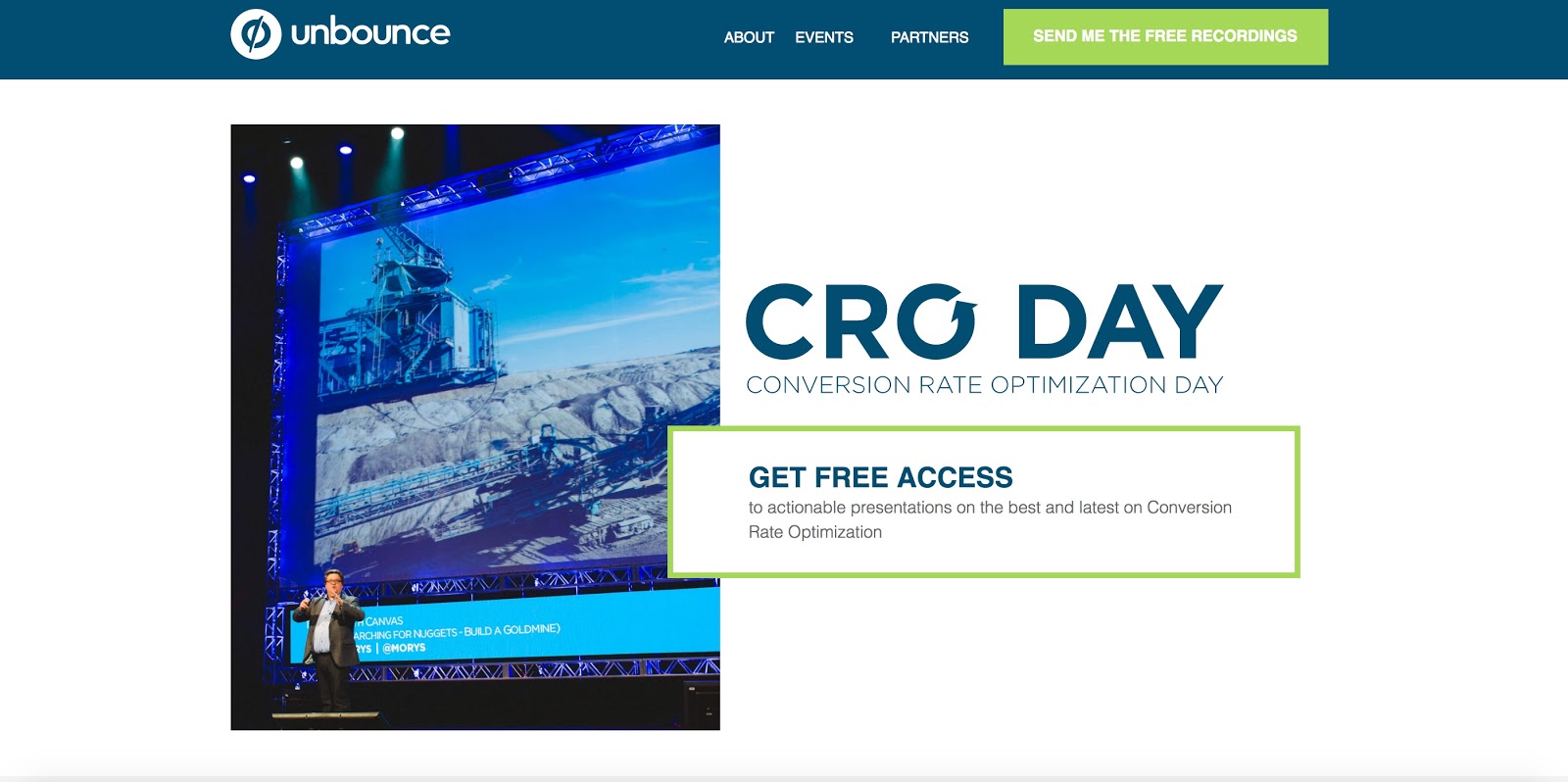
It was April, 2015 and CRO day was coming up. So Dane started inviting influential friends to attend a KlientBoost sponsored “Taco Party” during the event.
His first invite was to Sean Work, who was the Director of Inbound Marketing at KissMetrics at the time. Dane says he “randomly ran into at a Starbucks in Huntington Beach” (a serendipitous side effect to the Starbucks strategy). He also invited other folks in the industry with established credibility such as Aaron Orendorff, a well-known freelance writer, and Julia Stead, the Director of Demand Gen at the calling company Invoca.
They built attendance through ads and promotion by Unbounce. In the end “our party at CRO day had just as many attendees as Unbounce’s did,” he says.
From Event Partnerships to Content Partnerships
After CRO day, they doubled down on this new strategy and started co-producing content with non-competitive brands that served the same audience. “I started getting really aggressive and saying, ‘Hey, let’s create these guides with other companies and start doing webinars,’” he explains.
One of the early guides they created was around getting phone leads from PPC. As Dane describes it, “In the PPC world if people want to make sales offline, phone leads are very valuable. So we reached to every single call tracking provider, not even expecting that they would all say yes to wanting to create an ebook with them.”
But they all said yes.
KlientBoost had the enviable problem of having to say no to a bunch of these companies. They first produced their own phone leads guide and then ended up producing a retargeting guide with the call tracking company Invoca.
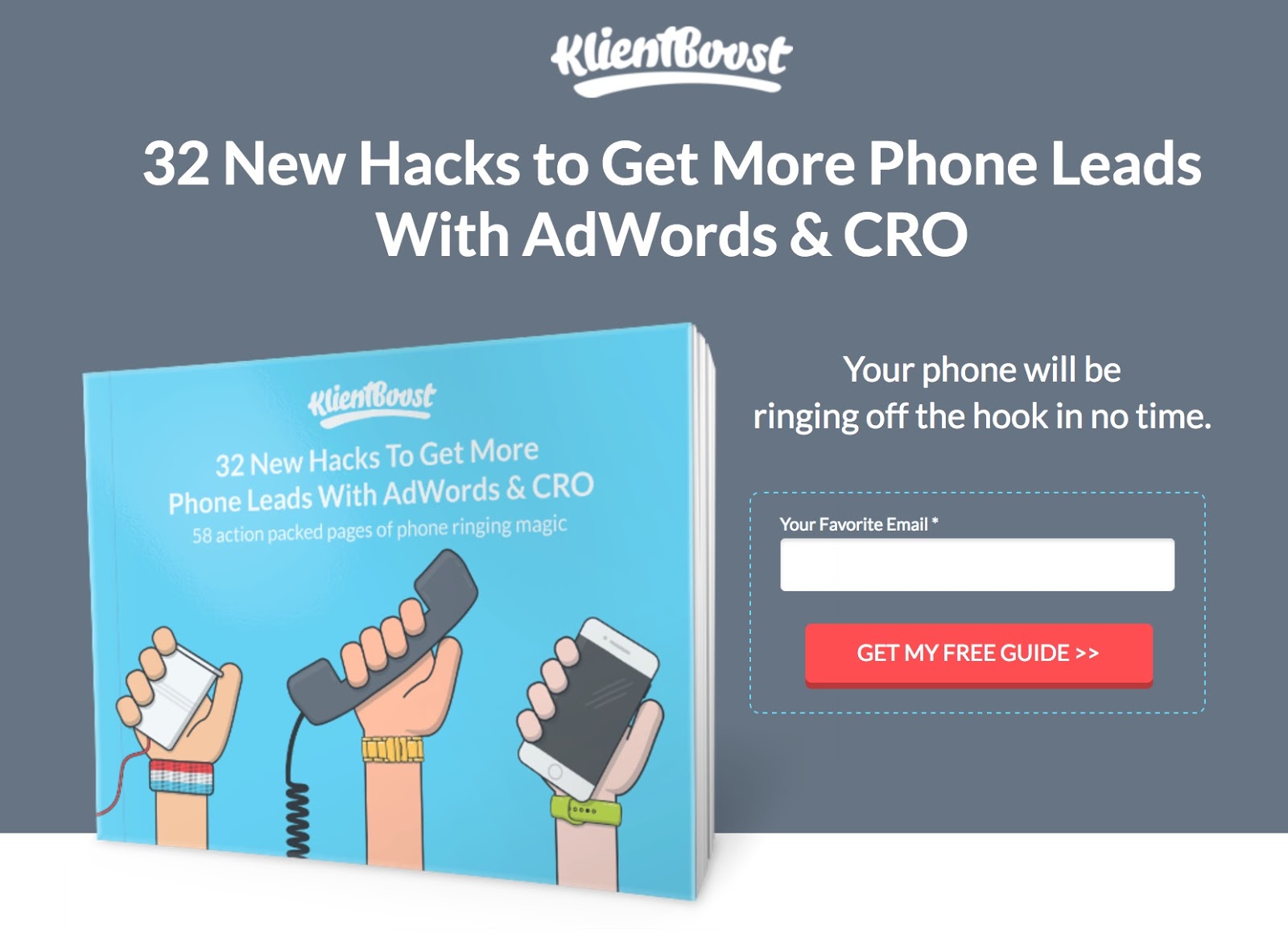
The lesson here is, if you discover that a new marketing strategy is valuable, go for it. Don’t just dip your toe in. Large results come from large amounts of effort.
Today, KlientBoost has an entire page of resources filled with webinars (with other brands), ebooks, speaking engagements, and more.
Initially, traffic to KlientBoost’s website was still hard to come by: “I’m going through the motions, nothing is really happening with this blog. The content marketing is not working for me,” he says.
But regardless of site traffic being low, the partnerships continued to expose KlientBoost to their target audience.
Several months into 2015, they reached $50,000 in monthly recurring revenue. The partnerships were bearing fruit. That’s some fast growth, and Dane is quick to mention it was due to landing some large clients (“Moby Dicks” as he calls them) early on.
Slowly Building Traffic to 50,000 monthly uniques and obsessing over design
The traffic to KlientBoost.com was slow to build but eventually it became steady. Dane attributes this to the slow accumulation of lots of tactics and techniques eventually adding up to get results: guest posting (in particular their strong relationship with Unbounce), constant blogging, content partnerships, and design.
Yes, design.
It’s another theme that keeps coming up as we talk: differentiating his brand with good design. Remember, even his first hire (before they had a single client) was a designer, who Dane paid out of his savings until revenue arrived. Their second hire was a designer as well.
When I ask about how he eventually got site traffic to increase, I’m surprised when he goes back to talking about design. “Caring about the brand building and the design of it,” is the first thing he says.
But he attributes a lot of their content based results to establishing themselves as a trustable, professional agency, in a sea of solo operations that call themselves PPC agencies. “There’s a new PPC agency popping up every day,” he says. “The barrier to entry is so low. ‘I changed a landing page button color and conversions went up 3%? Guess what, I have a new agency. Hire me.’”
From the beginning, he wanted the KlientBoost brand to exude professionalism — to immediately separate itself from the “I just started this ‘company’ yesterday on the side as an experiment” crowd.
“Meaning, if you look at our website (again, subjective, some people might like it, some people might not), but if you look at the time and attention to detail that we put in versus other agencies, it’s very clear that we care about our brand and that we show good for it. And that’s such an x-factor in my mind.”
But Dane is also quick to point out that this professionalism is balanced by their (his) fun personality. He points me to Michael Dunsterville’s “butt-touching” bio as an example, and says things like this surely “has turned off a lot of clients.”

They also didn’t spend much effort along the way on growing their email list. Instead they focused all calls to action on their product, something we’ve written about and modeled extensively before.
Today, 2 years into KlientBoost, they average about 50,000 monthly unique visitors. From that, they get 30 – 40 inbound leads a week, or about 150 leads a month. That’s a 0.4% conversion rate, a good, yet very achievable conversion rate for many B2B companies.
But most of those leads are not qualified, and the qualification process is part of our next and last phase in our story.
Phase 3: Creating Systems to Qualify Leads at Scale
With 30 – 40 leads coming in every week, you need a process for qualifying and closing those leads. In particular because a large percentage are not qualified (they only have 80 clients, which goes to show how many they’ve turned away in the past two years).
The central theme of their process has similarities to the cold emails that Dane sent years ago: generously give ideas to prospects.
Step 1: When a web lead comes in, Dane sends it to one of their account executives, who uses LinkedIn to see if the company has a decent employee count and SpyFu to see if they are spending sufficiently on ads.
Step 2: They reach out to the prospect.
Step 3: They have their first call. Here, they validate some of their SpyFu snooping to confirm the lead is qualified with this question:
How much are you spending on ads?
Step 4: If they’re spending enough, then KlientBoost does an audit. In the audit, they’ll brainstorm ideas for how to improve a client’s PPC campaigns, for free. They send over a proposal describing all of these ideas that the client could and should do. But they still have not brought up price.
They don’t worry about whether the client is going to “steal” their free advice because they’ve done the work upfront to qualify these leads. Dane says only about 3 – 4 of the 30 – 40 weekly leads even make it to this step. If they do, KlientBoost knows this company is spending a lot on ads- which means they have the budget to hire an agency to manage them.
Step 5: They have a call to go over the proposal of ideas. They answer all questions honestly and don’t hold back any “insider info” or “secret sauce.”
Then, and this is critical, at the end of this call, they ask this question:
“If we were able to improve performance by 50%, what would that mean in terms of money being made for you?”
Remember, price hasn’t been broached yet. This question lets the client (in their own words) think of what the ROI of improved PPC performance would be. “It’s their death sentence…in a good way,” says Dane.
If they say “Oh we’ll easily make $10k more a month.” KlientBoost can come in with a proposal of $4k, and as Dane puts it “paying $4k to earn $10k is a pretty easy bet.”
Advice to New Agencies and Looking Back on Acquiring B2B Customers
Currently, KlientBoost has over 16 account managers (to manage 80+ clients) and does over $300,000 in monthly recurring revenue. Dane is able to spend most of his time on this sales process as well as speaking, building partnerships, and brand building.
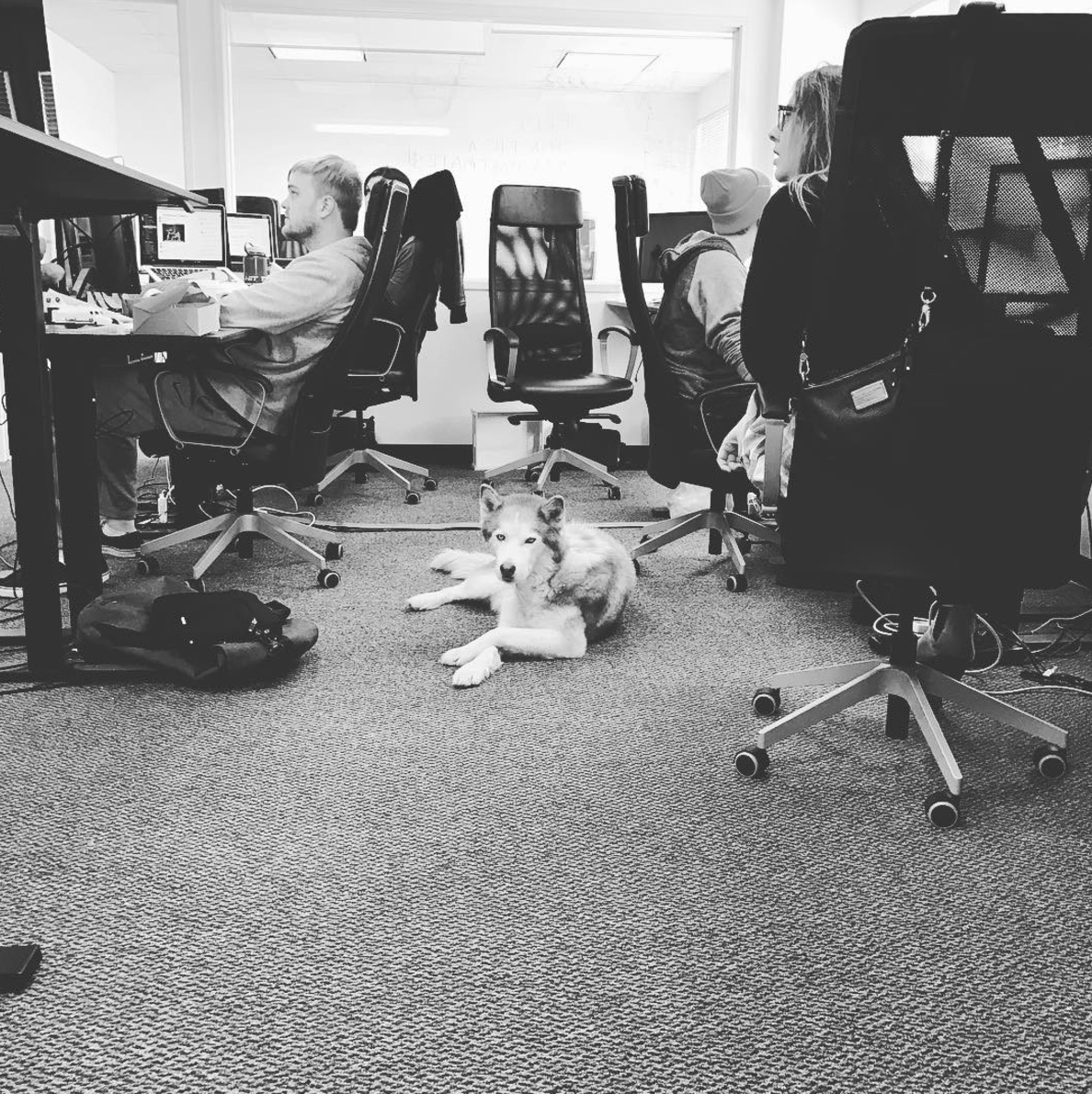
They’ve also doubled down on content production, and hired someone to promote content full time – which has helped build systems around the engine that continues to fuel their growth.
Towards the end of our conversation, we began to talk about what he would do differently and what advice he would give to new agencies. We talked about so many different tactics through different phases of growth that it’s hard to pin down any single tactic that stands out.
Instead, his mind goes to a simple strategy that Dane has relied on from the beginning: “Be more personal. Be more custom. But above all else, start doing.”
In essence, it’s a strategy around building relationships, treating the client like a friend, and giving them honest advice- whether it’s sending them personal idea-filled cold emails or a personal idea-filled proposal.
He said he’d ask a young agency owner
“Do you have the ability to actually fly out and meet them? Do you want to take that gamble? Or that investment to make that happen?”
“Even for a $3k a month deal?” I ask.
“Even if it’s a $3k/month deal,” he says. “Because of lifetime value, it’s so worth it.”
“One client that we just wrapped up with us, worked with us for 19 months,” he explains. “Total value to us was $86,920. Is that worth a there-and-back same day flight of $500? If that helped you close one deal in every 10, it’d still be worth it multiple fold.”
Towards the end, we discuss how: even after you “land” the B2B client the relationship building isn’t over. “If you keep meeting with them, keep being friends with them, they’ll find ways to keep you on,” he said.
Because in the end, “It’s hard to fire a friend.”
Want us to write an in depth case study or story like this about you or your company? We’ll also drive traffic to it. Apply here.
Like this article? We produce stories like these for our clients, learn more here.
More Stories Like This
Patrick Campbell Founder of ProfitWell Shares Why He Chose Scale Over Lifestyle
How Examine.com Founder Sol Orwell Built A 7-Figure Business Off Of Reddit
Our Conversion Calculator Spreadsheet
Where should we send the link?
We'll send it by email and add you to our free newsletter, where we send in depth content marketing articles (like this one) as well as exclusive email-only ideas about once a week. It's free and you can unsubscribe at any time.

